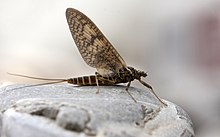
In biology, a nymph is the immature form of some invertebrates, particularly insects, which undergoes gradual metamorphosis (hemimetabolism) before reaching its adult stage. Unlike a typical larva, a nymph's overall form already resembles that of the adult, except for a lack of wings. In addition, while a nymph moults, it never enters a pupal stage. Instead, the final moult results in an adult insect. Nymphs undergo multiple stages of development called instars.

Mayflies are aquatic insects belonging to the order Ephemeroptera. This order is part of an ancient group of insects termed the Palaeoptera, which also contains dragonflies and damselflies. Over 3,000 species of mayfly are known worldwide, grouped into over 400 genera in 42 families.

In biology, the imago is the last stage an insect attains during its metamorphosis, its process of growth and development; it is also called the imaginal stage, the stage in which the insect attains maturity. It follows the final ecdysis of the immature instars.
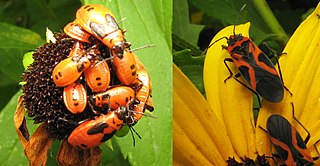
Hemimetabolism or hemimetaboly, also called partial metamorphosis and paurometabolism, is the mode of development of certain insects that includes three distinct stages: the egg, nymph, and the adult stage, or imago. These groups go through gradual changes; there is no pupal stage. The nymph often has a thin exoskeleton and resembles the adult stage but lacks wings and functional reproductive organs. The hemimetabolous insects differ from ametabolous taxa in that the one and only adult instar undergoes no further moulting.

Ephemera danica, the green drake or green drake mayfly, is a species of mayfly in the genus Ephemera.
Cinygmula is a genus of flatheaded mayflies in the family Heptageniidae. There are at least 30 described species in Cinygmula.
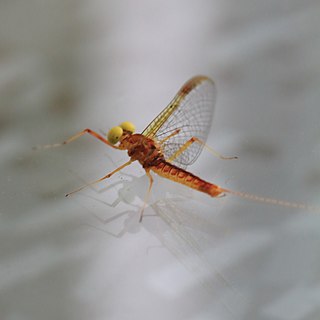
Heptagenia is a genus of flatheaded mayflies in the family Heptageniidae. There are at least 20 described species in Heptagenia.

Rhithrogena is a genus of flatheaded mayflies in the family Heptageniidae. There are at least 150 described species in Rhithrogena.

Callibaetis is a genus of small minnow mayflies in the family Baetidae. There are at least 30 described species in Callibaetis.
Fallceon is a genus of blue-winged olives in the family of mayflies called Baetidae. There are about 19 described species in Fallceon.
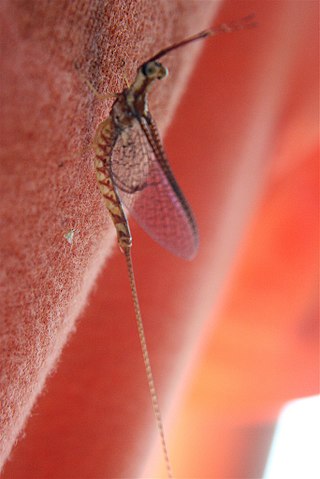
Hexagenia limbata, the giant mayfly, is a species of mayfly in the family Ephemeridae. It is native to North America where it is distributed widely near lakes and slow-moving rivers. The larvae, known as nymphs, are aquatic and burrow in mud and the adult insects have brief lives. They are often referred to as fish flies around the Great Lakes as they tend to cause the areas around water to smell like rotten fish.
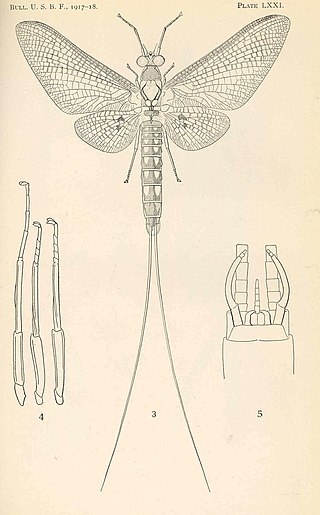
Hexagenia bilineata is a species of mayfly in the family Ephemeridae. It is native to North America where it is found in the Upper Mississippi Valley. Sometimes adults of this mayfly are so abundant as to cause a nuisance because of their enormous numbers. The larvae are aquatic and burrow in mud and the adult insects have brief lives.

Leptophlebia marginata, the sepia dun, is a species of mayfly in the family Leptophlebiidae. It is native to Europe and North America where it is distributed widely near lakes, ponds and slow-moving streams. The larvae, which are known as nymphs, are aquatic.

Prosopistomatidae is a family of mayflies. There is one extant genus, Prosopistoma, with several dozen species found across Afro-Eurasia and Oceania. They are noted for their unusual beetle-shaped larvae, which live beneath rocks and stones along the gravelly lower reaches of rivers. Their ecology is unclear, but they are probably carnivorous. They are closely related to Baetiscidae, with both families being placed in the Carapacea.
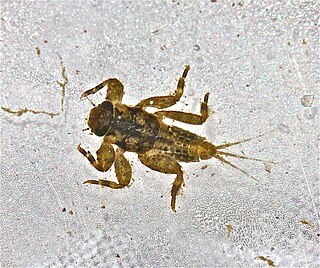
Drunella is a genus of spiny crawler mayflies in the family Ephemerellidae. There are at least 20 described species in Drunella.

Potamanthus luteus is a species of hacklegilled burrower mayfly in the family Potamanthidae. It is or was found principally on the Rivers Usk and Wye in the UK; in the Usk it may have become extinct and in the Wye it has suffered a population crash.
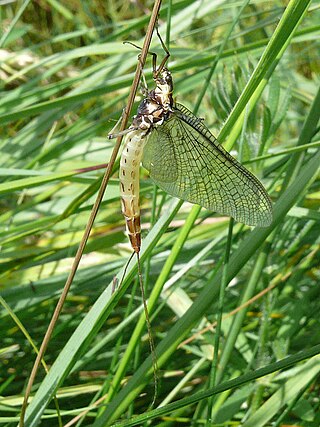
Polymitarcyidae is a family of pale burrower mayflies in the order Ephemeroptera. There are about 10 genera and more than 90 described species in Polymitarcyidae.

Nesameletidae is a family of mayflies in the order Ephemeroptera. There are at least three genera and about eight described species in Nesameletidae.
